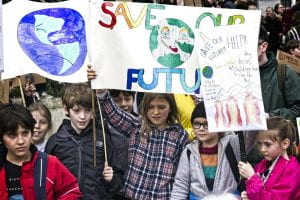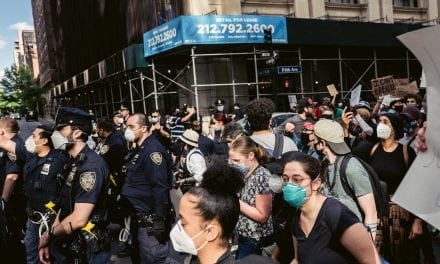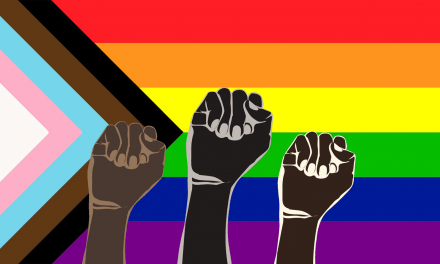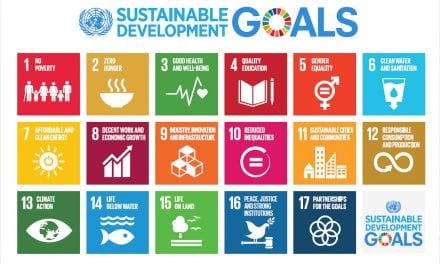Isolated in the South Pacific Ocean, the groups of low-lying islands that constitute the Republic of Vanuatu are assailed by frequent storms and constantly threatened by the impacts of sea-level rise, marine pollution, and ocean warming. At risk of oceanic submersion by the end of the century (even after over 30 years of pleading with large emitters to reduce their greenhouse gas emissions), these and other Small Island Developing States (SIDS) appeared before the International Tribunal for the Law of the Sea (ITLOS) in Hamburg, Germany. The objective of this appearance was to question whether carbon emissions absorbed by the ocean are considered marine pollutants that violate the United Nations Convention on the Law of the Sea (UNCLOS). [1] Instead of suing for damages, the commission of SIDS sought an advisory opinion regarding the specific obligations of State Parties to the UNCLOS to “prevent, reduce and control pollution of” and “protect and preserve” the marine environment, specifically in relation to the “deleterious effects that result from” climate change, sea level rise, and ocean acidification. [2] This strategy is not uncommon, as SIDS are increasingly navigating international judicial forums like the ITLOS as alternate routes toward climate justice when mainstream diplomatic pathways dominated by powerful, high-emitting states have only yielded continued inaction. Though the tangible outcomes of these legal proceedings remain questionable, the recourse to international law is indicative of the resilience and perseverance of nations like SIDS that have been otherwise historically marginalized and let down by climate action policy.
SIDS and Climate Change
Vanuatu is just one of the 39 states included in the United Nations’ distinct grouping of “Small Island Developing States,” or those that similarly face unique economic challenges and environmental vulnerabilities. Such vulnerabilities include the disproportionate damage inflicted by climate change on these developing islands, especially considering their own historically low carbon footprints. [3] For example, due to their due to their unique geographic locations and large average Exclusive Economic Zones, SIDS are exceptionally vulnerable to the impacts of ecosystem degradation and biodiversity loss, which further diminishes local access to natural resources and economic vitality. [4] The 2022 assessment report published by the Intergovernmental Panel on Climate Change (IPCC) found that both natural and human systems in SIDS suffer from tropical cyclones, storm surges, flooding, and droughts that result from increases in global temperature. [5] Even aside from these devastating events, slow onset climate change impacts like sea level rise further existentially threaten the survival and viability of SIDS, as climate-induced ocean changes are decreasing coastal area habitability. Habitability reduction in SIDS already poses significant implications for infrastructure and economic resilience, along with human security and migration dynamics. And yet, the IPCC report expected these risks to persist, even under unlikely adherence to the Paris Agreement to limit global warming to 1.5°C above pre-industrial levels. [6]

SIDS and Climate Litigation
In regard to attempts at remedying these discrepancies through traditional diplomacy and policy-making measures, SIDS remain relatively marginalized in global geopolitics, due in part to their small populations, limited institutional capacities, scarce financial resources, and vulnerability within the international economy. [7] This marginalization has generated the need to seek out more creative routes toward equitable climate action, such as that pursued by Vanuatu and other SIDS at the ITLOS.
The aforementioned example is far from the only instance of marginalized groups turning to international courts after more traditional diplomatic mechanisms have failed to deliver corporate accountability, governmental transparency, or tangible actions toward climate justice. In fact, “The 2023 Global Climate Litigation Report,” published by the UN Environment Programme, found that “the total number of climate change court cases has more than doubled since 2017 and is growing worldwide,” across all jurisdictions. [8] Further, in 2022 17% of all cases reported were in developing countries, including Small Island Developing States, with an additional prominence of environmentally vulnerable claimants like children, Indigenous Peoples, and women’s groups. [9] As demonstrated by the increasing prevalence of climate litigation, international courts are becoming key mechanisms for states seeking climate justice. This is especially true for states like SIDS, which have been failed by existing policies and excluded from equitable protections, and thus continue to disproportionately suffer the consequences of inaction from large-emitters as a result.
Why Request Advisory Opinions?
Though SIDS have been increasingly resorting to climate litigation out of necessity and desperation, many question the practical significance and tangible impact of international court proceedings on climate action. A main critique of utilizing this method arises from the voluntary buy-in and non directly-enforceable (as by some superior, supranational governing entity) nature of international law due to principles of state sovereignty. This critique is further accompanied by doubts surrounding the likelihood of state adherence to international court opinions in any way that would impactfully shape their practices, such as through incorporation into domestic law and policy. [10] However, the demonstrated willingness to chase the unpromised merits of an international court ruling illuminates both the direness of the climate crisis, and the perseverance of SIDS that continue to seek justice through any remaining methods, including the unconventional and inauspicious.
To revisit the case from the introduction, for example, although an advisory opinion from the ITLOS would be nonbinding in itself, the interpretation would still inform the development of future laws and offer “an authoritative statement on legal matters that could guide countries as they craft climate protection law” along with, “legal clarity on nations’ climate obligations under the courts.” [11] These statements then, “may also be cited in cases in domestic courts and will help those who bring countries or companies to court over their climate-related acts or omissions.” [12] Citing advisory opinions in domestic courts, in turn, would expand the existing legal precedent regarding greenhouse gasses to promote successful proceedings for similar claims, especially in national jurisdictions where “activists are increasingly taking on governments and energy companies for climate damage and have achieved some successes.” [13] In this manner, the voluntary buy-in laws and seemingly unenforceable rulings produced by climate litigation in international courts still have the ability to generate policy action toward climate justice. They can adopt enforceability through their application as the legal precedent that supports similar decisions in other jurisdictions that do actually have direct enforcement mechanisms. And so, SIDS resort to seeking justice through the provision of this legal groundwork in the hopes that it might still impact policy through citation in future national or regional proceedings that have more potential for direct enforceability.
Aside from the legal merits of serving as precedent to enhance the integrity of climate litigation in other jurisdictions, SIDS also seek rulings from international courts due to their normative merits. To elaborate upon the previous example, in March of 2023 the same SIDS that initiated proceedings at the ITLOS also requested an advisory opinion from the International Court of Justice (ICJ). This request sought an opinion “on the obligations of States under international law to ensure the protection of the climate system from anthropogenic emissions of greenhouse gases” and on the legal consequences for States that have, through their actions and inactions “caused significant harm to the climate system with respect to…in particular, Small Island Developing States.” [14] Once again, despite questions of direct enforceability, experts remain hopeful about the resolution’s potential to serve as a catalyst for bolder climate action that favors SIDS. As the Head of the Frontiers in Environmental Law Unit at the Law Division of the United Nations Environment Programme posits, “A strong ICJ opinion will shape the discourse around climate action and accountability” by adding “fresh and significant momentum” to climate commitments. [15] This is to say that a resolution that legally defines ocean warming as being caused by marine pollution derives its significance from the ICJ’s normative ability to shape state discourses and values surrounding the strength of climate action plans. The ICJ and other international courts being mobilized by SIDS are esteemed sources of moral authority within the international community. Thus, their rulings could at least offer some legal prestige with which to skew international interests in the direction of strengthened commitment to climate justice obligations.

Finally, SIDS that are disproportionately impacted by climate change utilize international courts to connect their pending climate litigation claims with pre-existing or widely-accepted legal precedents. There are practical merits to forging these connections. For example, the “General comment No. 26 (2023) on children’s rights and the environment, with a special focus on climate change” called upon provisions from the Convention on the Rights of the Child to propose an “evolution of international law on human rights and the environment.” A main function of this interpretation was to outline State and business sector obligations to complete the “general measures of climate mitigation implementation” that were recommended under the proposed rights-based approach to preventing environmental degradation. [16] An analysis of the document by the Columbia Climate School’s Sabin Center for Climate Change Law emphasized the political utility of placing issues of climate justice into the context of the most widely ratified human rights treaties. [17] It found that the authoritative linkage between climate equity and previously agreed upon human rights obligations allows for “a wider range of responses to noncompliance at the international level” and “broadens the reach of legal mechanisms available to prompt a more active role from governments, as well as other stakeholders, such as private companies, to adopt measures to mitigate climate change.” [18] In this regard, SIDS that have turned to international courts could strengthen the outcomes generated by voluntary pledges and weak climate policy commitments, such as those made under the Paris Climate Accord, by causing these commitments to assume associated legal and human rights obligations. In this way, the legal authority of international human rights treaties could be applied to SIDS’s climate claims to further validate previously unanswered demands for accountability and compliance with mitigation efforts.
Concluding Thoughts
As sea levels and atmospheric temperatures continue to rise, so too do the number and frequency of climate litigation cases raised by SIDS and other disproportionately impacted groups. However, questions persist surrounding the effectiveness of these rulings in actually enhancing climate justice and preventing future harm, with much of the contribution dependent upon decisions in currently pending cases as well. [19] Concerns of effectiveness aside, though, seeking legal opinions from international courts remains the “best defense” for SIDS and other actors coping with slow progress and persistent inaction through other diplomatic channels. The alternative course of action offers the tiny island nations an outlet through which to “raise [their] voice creatively in international diplomatic talks” as explained by Nikenike Vurobaravu, the president of Vanuatu. [20] He elaborates that the repeated presence of SIDS at the world’s highest judicial bodies is an effort to “think outside the box” and “learn how to manage our unimportance.” [21] In this sentiment, then, the increasing mobilization of international law illuminates the direness of the environmental crisis that has justified resorting to these provocative legal measures. However, SIDS’ increasing usage of international courts also highlights the coerced resilience and persistent willingness of even the most environmentally degraded, economically unempowered, politically marginalized, and geographically isolated states to do what they can: exhaust all options in pursuit of justice.
References
- Volcovici, Valerie, and Riham Alkousaa. “Island States Seek Climate Protection from Law of the Sea.” Reuters, September 11, 2023. https://www.reuters.com/business/environment/island-states-seek-climate-protection-law-sea-2023-09-11/.
- “ITLOS/ Press 328.” International Tribunal for the Law of the Sea. ITLOS/TIDM, December 16, 2022. International Tribunal for the Law of the Sea. https://www.itlos.org/fileadmin/itlos/documents/press_releases_english/PR_328_EN.pdf.
- Office of the High Representative for the Least Developed Countries, Landlocked Developing Countries and Small Island Developing States. “About Small Island Developing States.” United Nations, 2023. https://www.un.org/ohrlls/content/about-small-island-developing-states.
- Ibid. Exclusive Economic Zones are defined as the area of territorial sea generally extending 200 nautical miles of the shore within which a coastal State has the right to explore and exploit, conserve and manage, and generally exercise sovereign jurisdiction over living and nonliving resources.
- Mycoo, M., M. Wairiu, D. Campbell, V. Duvat, Y. Golbuu, S. Maharaj, J. Nalau, P. Nunn, J. Pinnegar, and O. Warrick, 2022: Small Islands. In: Climate Change 2022: Impacts, Adaptation and Vulnerability. Contribution of Working Group II to the Sixth Assessment Report of the Intergovernmental Panel on Climate Change [H.-O. Pörtner, D.C. Roberts, M. Tignor, E.S. Poloczanska, K. Mintenbeck, A. Alegría, M. Craig, S. Langsdorf, S. Löschke, V. Möller, A. Okem, B. Rama (eds.)]. Cambridge University Press, Cambridge, UK and New York, NY, USA, pp. 2043–2121, doi:10.1017/9781009325844.017.
- Ibid.
- Office of the High Representative for the Least Developed Countries, Landlocked Developing Countries and Small Island Developing States. “About Small Island.”
- United Nations Environment Programme. 2023. Global Climate Litigation Report: 2023 Status Review. https://wedocs.unep.org/20.500.11822/43008
- UNEP. “Climate Litigation More than Doubles in Five Years, Now a Key Tool in Delivering Climate Justice.” UN Environment Programme, July 27, 2023. https://www.unep.org/news-and-stories/press-release/climate-litigation-more-doubles-five-years-now-key-tool-delivering.
- UNEP. “UN Resolution Billed as a Turning Point in Climate Justice.” UN Environmental Programme, March 31, 2023. https://www.unep.org/news-and-stories/story/un-resolution-billed-turning-point-climate-justice.
- Volcovici, Valerie, and Riham Alkousaa. “Island States Seek Climate Protection”.
- UNEP. “UN Resolution Billed”.
- Simons, Marlise. “Island Nations Hope for Court’s Help on Climate’s Effects.” The New York Times, September 11, 2023. https://www.nytimes.com/2023/09/11/world/asia/island-nations-ocean-court-climate.html
- United Nations. “Seventy-Seventh Session, 64th & 65th Meetings: General Assembly Adopts Resolution Requesting International Court of Justice Provide Advisory Opinion on States’ Obligations Concerning Climate Change.” In United Nations Meetings Coverage and Press Releases. Accessed October 9, 2023. https://press.un.org/en/2023/ga12497.doc.htm#:~:text=The%20General%20Assembly%20today%20adopted,long%20struggle%20for%20climate%20justice.https://press.un.org/en/2023/ga12497.doc.htm.
- UNEP. “UN Resolution Billed”.
- Committee on the Rights of the Child, Convention on the Rights of the Child General comment No. 26 (2023) on children’s rights and the environment, with a special focus on climate change § (2023).
- Tigre, Maria, and Asteropi Iliopoulos. “Climate Litigation and Children’s Rights: Unpacking the CRC’s New General Comment.” Web blog. Climate Law: A Sabin Center Blog (blog). Columbia Law School: Columbia Climate School Sabin Center for Climate Change Law, September 7, 2023. https://blogs.law.columbia.edu/climatechange/2023/09/07/climate-litigation-and-childrens-rights-unpacking-the-crcs-new-general-comment/.
- Tigre, Maria. “Major Developments for Global Climate Litigation: The Human Rights Council Recognizes the Right to a Healthy Environment and the Committee on the Rights of the Child Publishes Its Decision in an International Youth Climate Case.” Web log. Climate Law: A Sabin Center Blog (blog). Columbia Law School Columbia Climate School for Climate Change Law, October 12, 2021. https://blogs.law.columbia.edu/climatechange/2021/10/12/major-developments-for-global-climate-litigation-the-human-rights-council-recognizes-the-right-to-a-healthy-environment-and-the-committee-on-the-rights-of-the-child-publishes-its-decision-in-an-inter/
- Wewerinke-Singh, Margaretha. 2023. “Preventing Climate Harm: The Role of Rights-Based Litigation.” Wisconsin International Law Journal 40 (2): 245–60.
- Sengupta, Somini. “Tiny Vanuatu Uses Its ‘Unimportance’ to Launch Big Climate Ideas.” The New York Times, December 8, 2022. https://www.nytimes.com/2022/12/08/climate/vanuatu-president-nonproliferation-hague.html.
- Ibid.








You must be logged in to post a comment.